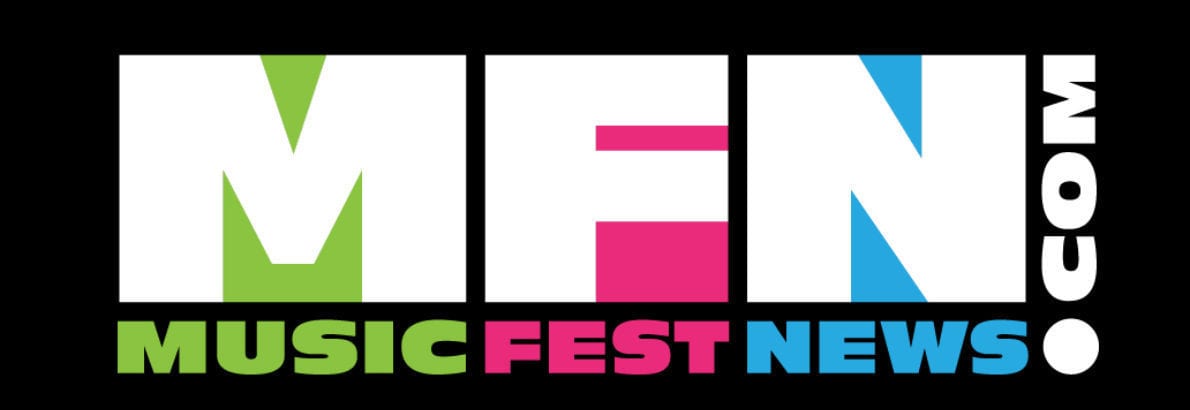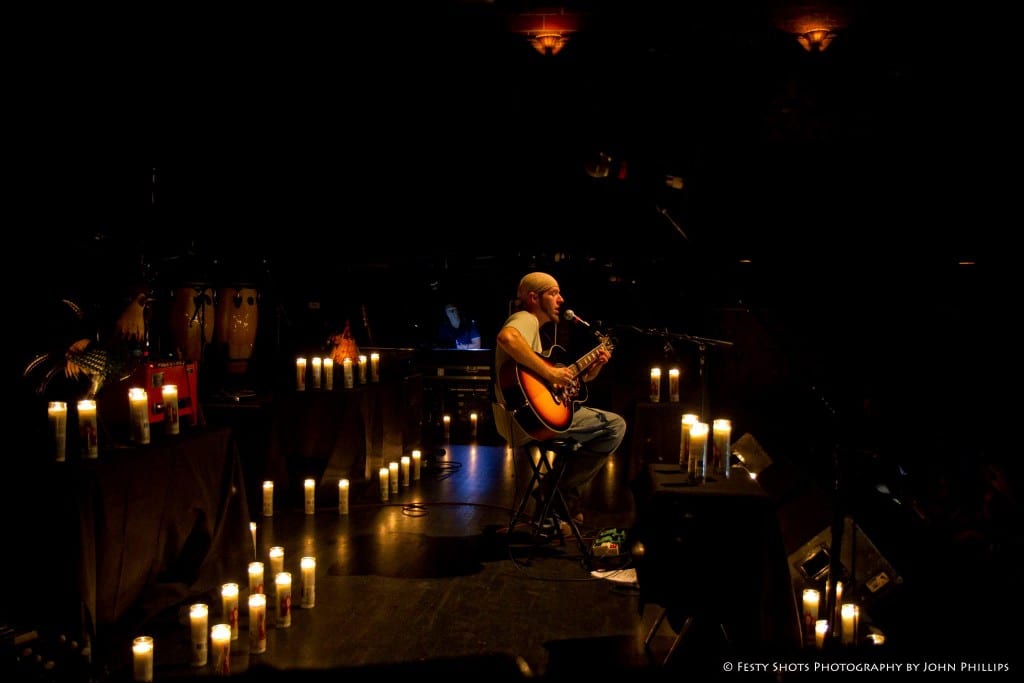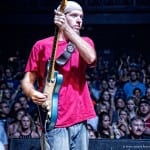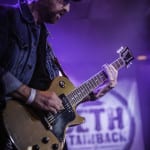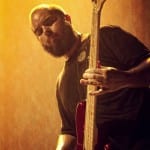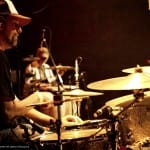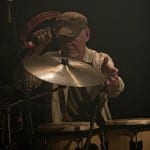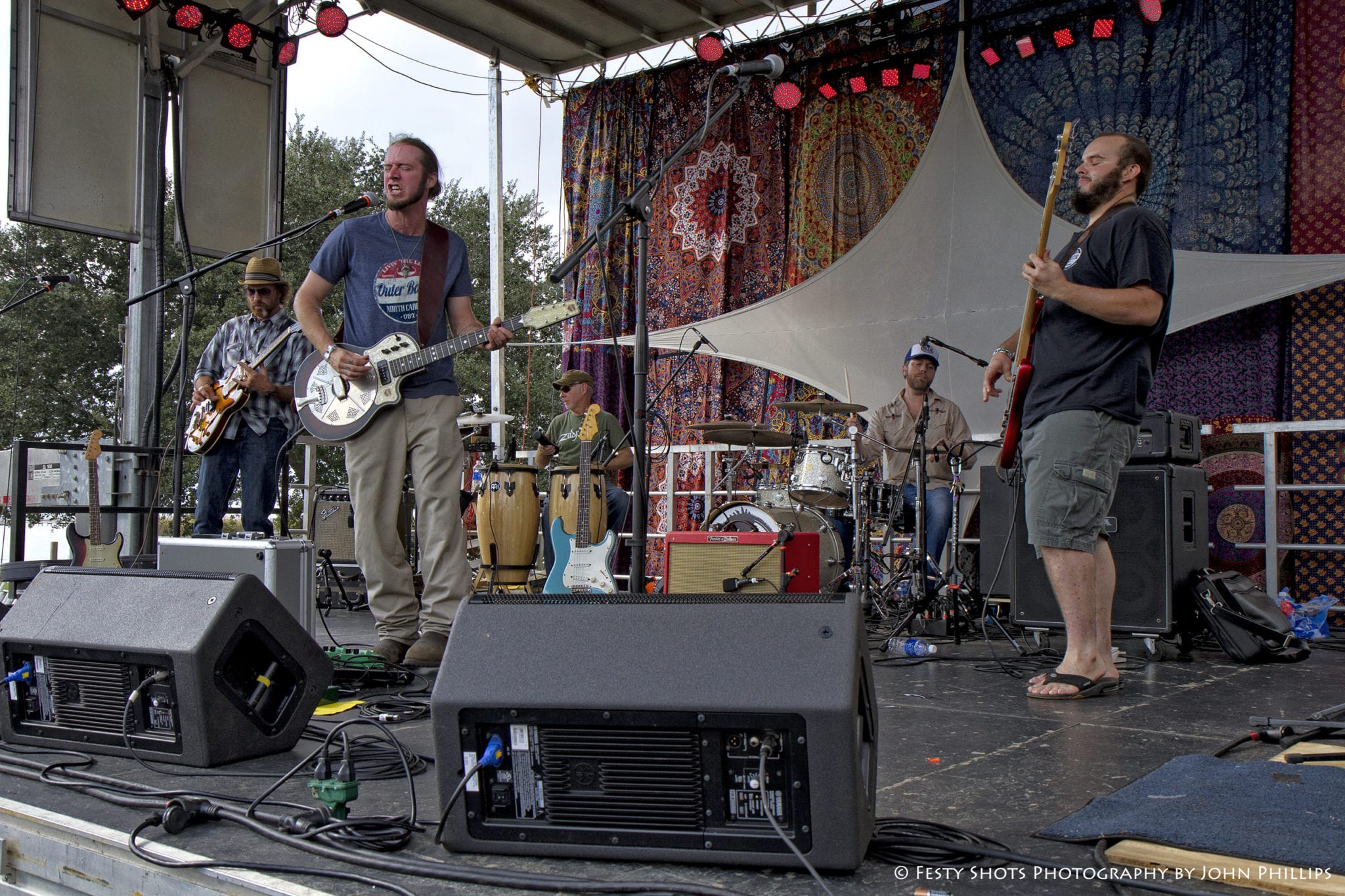
On The Rise: Seth Stainback & Roosterfoot
Call it the Tidewater Region, call it Hampton Roads, or call it the Seven Cities. It’s the area of southeastern Virginia that includes the cities of Norfolk, Virginia Beach, Portsmouth, Chesapeake, Suffolk, Hampton and Newport News. It’s a maritime region at the mouth of the Chesapeake Bay, and home to the world’s largest naval base. And it’s out of the shipyards in the region that the working-class sound of Seth Stainback & Roosterfoot emerged. Front man Seth Stainback has worked all over the country as a welder, all the while writing songs about his experiences, about being lonely on the road, and about life in general. Born in Texas and raised in the Carolinas, he grew up around music. His songs are heavily influenced by Texas country bands, delta blues, and the gospel music that his mother sang professionally. He’s a man of faith, but a sinner like the rest of us. And while his music wouldn’t necessarily be well received at Sunday services, he can damn sure take a crowd to church.
Comprised of Seth on guitar and vocals, the band is filled out with Larry Berwald (a former member of the 70’s Southern rock band Wet Willie) on lead guitar, Steven Yewcic on bass, and Jason Bruner on drums. A recent addition is Stephen Lazar, a multi-instrumentalist who has played keyboards and bass at some recent gigs. The band has two albums, 2013’s Earth & Worm, and Fire & Steel, released in June of 2014 and produced by Anders Osborne. Within a few months of the current lineup forming, they opened for Bob Seger and The Silver Bullet Band. They’ve also opened for Hank Williams, Jr., ZZ Top, B.B. King, Robert Earl Keen, Big Head Todd and The Monsters, and Anders Osborne. They made their first big festival appearance at FloydFest, playing two sets in 2014. Everybody must have liked them because they’ve been invited back this year.
Seth is a skillful songwriter with a soulful voice, equally comfortable singing an acoustic ballad as he is belting out a hard rocker. I had the opportunity to sit down with Seth recently for the most extensive interview he’s given to date.
Your last album, Fire & Steel was produced by Anders Osborne. How did that collaboration occur?
Seth Stainback: I ran into a guy in Memphis that said Anders was about to produce his album. I said “How’d you do that?” and he said “I asked him”. That’s always been my mantra. Some people make things real complicated, but sometimes all you need to do is ask. We had opened a couple of shows with him when Jason Bruner came aboard on drums, a little three day run two years ago. He came back into town for a show and we ran into his manager and started up a conversation. It was real casual, just us hanging out in the crowd. We started shooting the breeze about working with Anders on our next project, and he said sure, send me the info and we’ll review it and figure it out. A little while later I got a phone call from the 504 area code, and I was like “I think I know who that is”.
So what was that like. How did he influence the music you were making?
Seth Stainback: Working with Anders was really, really great. He’s so at home in that setting, and he’s been doing it for so long it’s like being in his living room. He’s kinda like me, coming from a raw, passionate stance, you know, not trying to get too technical but more like “let it come out, let it come out”. Let’s set the mood, let’s get everything right, let’s get to where you’re comfortable and you’re feeling it and we can get these emotions and conjure up something here and not just make songs, you know what I mean? Then he starts to pull out his technical knowledge. Now that we’ve conjured up this little ghost here, let’s put some color on him, let’s give him a face. Is he an old man? Is he a young man? I like that process because if you put in the details first, to me there’s no soul. So I want to make sure the soul’s in there and the passion’s in there, and then you can polish it up after that. He’s real down to earth, you know. It’s like talking to you right now. He and Warren (Riker, Grammy winning recording engineer) were both like that. It was great. I’ve been in studios before, but that was a whole ‘nother level for us, and for me personally.
You recorded the album at Dockside Studio outside Lafayette, LA. Tell us a little about that experience.
Seth Stainback: That was just another ace in the hole, you know what I mean? I miss being down South. I like Virginia and it’s been very good to me, but I don’t feel like I’m down South here. So it was nice to get back down South. The studio is in an old house by a river. It’s been there for over 100 years and it’s got that vibe, it’s got that flavor, it’s got a couple of ghosts of its own. There’s all this mojo in there and it’s just oozing from the walls. And you’re living upstairs, so you’re just enveloped in it. You get up and walk downstairs and kinda go into your living room and sit down and pick up your guitar, just like you’re playing at home, you know. Then you get warmed up and you make an album.
When you recorded Fire & Steel you chose not to use crowdsourcing to fund the project. Why is that?
Seth Stainback: It’s just how I was raised. I’m not knocking crowdfunding. I know a lot of people who do it But for me personally, I feel like our fans give so much already, I wouldn’t feel right asking them for more. They pay for the tickets, they buy your CDs, they buy your shirts, they support you, they spread the word, and you want them to pay for you to make an album too? And I know, the first thing I hear from everybody is “Oh, we want to support you”, and it’s like a pre-order and all that stuff. You can flip it any way you want, but for me personally, I don’t feel like it’s a square deal. I’ll take a loan from somebody, and I’ll pay you interest or whatever and to me that’s a square deal, that’s a handshake and an understanding. Is it harder? Hell yes. It’s made things really difficult, but there’s an old saying, “always stick to your guns”, and don’t change who you are. I feel like that was my first test in this whole musical pursuit.
And you’ve got to be able to live with it.
Seth Stainback: Yeah, and I just couldn’t live with that. Would I recommend it to everybody? Hell no. Go do a kickstarter, it’s really easy (probably) and people are gonna give you some money and, bam, you can go make your record and you’re not on the line. However, me personally, I always do things the hard way. Go ask my mother!
Speaking of your mother, you grew up around music, I know. How has your family upbringing and the music you were exposed to influenced your musical style?
Seth Stainback: It influenced everything I am and how I view the world, not only because of the music but because of the lifestyle. Early on, there was a lot of older Southern gospel, like when Mom was with PTL. But as her career kind of changed, it was more pop and things like that, so I heard all that. But I wasn’t allowed to listen to whatever I wanted to when I was a kid. If I went over to someone’s house and an album had a parental advisory sticker on it, I was like “Wow, holy crap! Your parents know you have this?” I didn’t grow up that way. I was not allowed to listen to that stuff. We were in church Sunday, Wednesday, and whenever else they had the doors open. So I was raised in that type of environment, and I had to go look for things. Stylistically, I’m very different from my family. Everything that I do now, musically, I had to go look for it. But there are things that I heard as a young man that are really heavily ingrained in me, and they’re familiar. And in my search for music, my ear always goes to those things because it’s this raw, primal thing with your earliest influences.
I think in particular the gospel piece of it, because you tend to put a little of that into some of your songs.
Seth Stainback: There’s this particular sound that Southern gospel has, that sound you heard when you went to church with your grandparents, those hymns and standards, there’s a particular sound there. It’s not even the words or the melody, it’s sonically, the tone of it, that touches people, and those are the things I’m always looking for. When Anders asked me what sound we we’re carving out for this record, or for a particular song, I tried to convey a sound I’ve been searching for my whole life. My MaMaw, mom’s mom, used to sit in front of her radio and listen to some great Texas radio stations. There’s a lot of old country music, stuff that you don’t normally hear on the radio in a lot of places. And man, the sounds of these old bands, it had that nice old reverb on it. When we’d visit my PaPaw, he’d parade me and my brother around town. We’d hit the post office, the barber shop, and then the bank. It was an old bank. Bonnie and Clyde robbed this bank. It’s one of those old buildings with lots of heavy woodwork and marble with a big high ceiling. They had this old mechanical porcelain hobo clown and if you cranked him up he’d whistle. And when this clown whistled, I remember that sound felt huge to me. Those are the sounds I’m looking for, and I haven’t found them yet. I have not harnessed them yet.
That’s a really great story. It’s those kinds of experiences that become ingrained in a person and it feels like home. When you feel something like that or hear something like that, it brings out an emotional response.
Seth Stainback: Especially nowadays. There’s so much music out there. But at the end of the day, no matter what my particular likes or dislikes are, when I hear a certain thing, there are only a handful of them that really hit me, that stick me right in the heart, and those influence me.
I’ve seen you play a number of different guitars, but that blue Fender Stratocaster seems to be your favorite. Tell us a little bit about it.
Seth Stainback: That was my first guitar, that’s it. I’ve had that guitar since I was 12 years old. It’s been everywhere with me. Been underneath a Greyhound bus from here to Texas a couple of times. That’s the one thing I’ve always kept. I don’t even have my yearbooks from school. I went through this phase where I wanted to just forget parts of my life. But that guitar, man, if I had to run into a burning house and grab something, my kids and that guitar would be coming out of the house with me. I’d die trying to do it. That guitar, that’s my voice, that’s the only voice I’ve got in this world, you know. I can honestly say when I’m playing music, and nine times out of ten it’s with that Stratocaster, there was nothing in this world that could bring me joy like that until I had children. Nothing.
You’ve interpreted a number of classic delta blues tunes like Grinnin’ In Your Face by Son House. What are some others?
Seth Stainback: The first one I learned, I don’t even know what the name is, but it’s an old Muddy Waters tune and it was one of the earliest recordings of him. He was still on the plantation and Alan Lomax came down there and was recording people, and he found Muddy Waters. He was like twenty years old at the time. And he’s got this one song that goes “Late in the evening, I feel like blowin’ my horn, I woke up this mornin’ and found my baby gone.” It’s got this melody to it, and that was the first one I ever learned. A lot of it can seem monotonous and people get tired of it really quickly. But to do it how it’s supposed to be done is a lot harder than people think. Old blues like that is very intricate. There’s a feel and an emotion there that can’t really be recreated. But my all time favorite delta blues guy is Charley Patton. Charley Patton is my dude. And I still haven’t learned all his stuff because it’s hard to learn, or at least it’s hard to learn properly. There’s no tablature out there to say how he was tuned. They tuned by ear, and especially some guys, they would just hit the E or whatever and get it in an open tuning. If you listen to a lot of these recordings, they’re like half up from here, or half up from there, but it’s an open tuning. It wasn’t like it is now.
Why does that music have such a pull on you?
Seth Stainback: I don’t know, man. I think it’s because that part of the country was such a huge part of my childhood. We made that ride from Carolina to Texas several times a year. My mother made sure we were there as much as possible so we didn’t forget our heritage. I just thought it was fun at the time, but I know now she did it for a reason. So Interstate 20 is a sacred place for me, honestly. There’s smells and sounds and feels, you know. It’s cool because you get to see the entire South and see the different aspects of it. There’s different quirks to the South, and I love them all. And that Mississippi-Louisiana section meant we were almost there. And it smelled so good because the air gets different. It might be just in my head but there was a different feel in the air once we crossed that bridge. It smelled good and it sounded good. Those things remind me of that. It’s soulful, and it’s heartache, and it’s great.
I know Stevie Ray Vaughan has influenced your music. Who are some other artists that you draw on for style and inspiration?
Seth Stainback: There’s not really that many. I’m the kind of guy that’ll find something and I’ll like it. Especially nowadays, because everybody will listen to everything, but there’s a handful of dudes I listen to. I’ll listen to Jimi Hendrix, I like Lynyrd Skynyrd, I like the Allman Brothers, and I like Stevie. So sometimes I’m like why should I shuffle through the whole deck when I can just pull out the ace. That’s not always the best way to go because there’s a lot of knowledge in the deck, you know. The joker’s got some knowledge, and the jack of diamonds, he’s got a little something, too. But when you’re in the mood and you feel like slapping that ace on the table, its SRV. Oh, and don’t let me forget Derek Trucks. Holy cow! I mean, seriously, who does it better? Show me somebody on the face of the Earth right now that can make a noise like that! That dude has gotten in touch with everybody’s soul and when he plays, I don’t care who you are, it moves you. He’s been playing at such a high level for such a long time You’re talking about a guy who, between the ages of 16 to 18, was simultaneously touring with his own band, Eric Clapton, and The Allman Brothers. So he’s been playing at a level of professionalism that most people will never see in their lives since he was 16. He’s incredible. SRV will always be my guy, but it’s a close race. Technically, you can say Derek’s a better player, but SRV just had that thang that he did that hits you in the heart. Most people play slide, they kinda dink around with it, but Derek, he hits that thing, he grinds it in there. That’s what SRV did, but Derek will take that finger, he’ll just bend that thing and just wail on it. I think he picked it up from a lot of those gospel cats that he listened to, and sacred steel music, like Aubrey Ghent and stuff like that, and they do the same thing. Robert Randolph does the same thing. Duane Allman did the same thing, man, and he was the first to do it. He took what Elmore James was doing and played it through two big ass Marshall stacks and turned it up, and put that power into that one note. Derek took that and went off into outer freakin’ space with it. It was like, yeah I want to play like that too except I’m gonna perfect it and get it better, plus I’m gonna learn fusion jazz on top of that. He’s got so many tricks in his bag it’s ridiculous.
I saw recently that you’re back on the bill at Floydfest for the second year in a row, and you’re also performing at Roosterwalk, a festival that sounds like it was named for you. How excited are you to get into the festival circuit?
Seth Stainback: Yeah, so I told Bruner if we’ve got a band called Roosterfoot and we can’t get on a festival called Rooster-something, we need to hang it up. But I’m happy to be a part of both of them, man. There’s nothing better than going out into the middle of the woods, or on top of a mountain, or wherever it is and hanging out for a couple of days, playing music. My favorite part of the whole thing is you finally get outside of where you’re living and you get out a little further into the world, and you hear some other stuff that’s going on. To me, that’s the main reason I want to get on the road. Not just to further whatever we’re doing. That’s a necessity. But man, I need to get fed. I need to hear what’s going on out there, I need something, I need some inspiration. I just want to hear different things, and I want to just soak it all up. I’m kinda dry right now between working and producing, and producing, and producing. Farmers will work a piece of land for a couple of years, then move to another section. If they don’t, it bleeds the land dry. It’s the same thing with creativity. If you’re not feeding yourself, you’re not gonna produce anything. And if you do try to produce something, it’s gonna be the shittiest fruit you ever had in your life.
Tell us a little bit about the other members of the band.
Seth Stainback: Well, Larry (Berwald), he was the first member of the band. Me and Larry have been playing together for almost four years now. We met at Abbey Road at an open mic. I’d been out there a few times and Larry came up there one night. I’d seen a few players around town that were pretty good, but my head is looking for a little different sound. Larry got up there and started playing, and I hadn’t heard anybody around town like that. Not just his prowess or his chops, you know, he gets that sound, he gets that tone, he gets those feels, he gets those riffs, he gets those bends. He’s just got that sound, because that’s the kind of sound he likes. There’s a lot of good players around here, but there’s nobody that’s got that sound. Nobody. You’ve gotta go down to Athens or somewhere to get that. It’s hard to come by around here, because this area doesn’t develop that kind of sound, you know. He’s from the Orange Belt, the Florida-Georgia line, he’s part of that mid-60’s/early-70’s Southern thing that was going on around there. And he soaked it up, and I got to meet him and hang out with him, and now we play music together. So Larry’s been my #1 road dog for awhile.
Then there’s (Steven) Yewcic. I was working at the shipyard when I was recording my first album, and Mickey Pellino (owner of Soul Haven Studios) said “You know, a cello would sound good on this”. I thought, yeah, it probably would. So I mulled it over in my head. A couple of days later I got put on another boat to work, and there was this young apprentice kid that I got paired with. Kind of a quiet guy that went about his business. I watched him work a little, and he got in there and fit that stuff tighter than guys that had been doing it for 30 years. Everything he did, he wanted it just right, and as a welder, that’s what you’re looking for. I didn’t have to build it up, I didn’t have to fix it, I just had to make one pass and weld it. So after a week we’re finally having conversations and I’m telling him about my music. He says, Yeah, I do a little music, too. I went to ECU (East Carolina University) for this and that. When I asked him what he played, he said cello. I was just meant to meet this kid, you know. So I told him we should hang out and play, because if he could play cello the way he fit steel, I knew I wanted him as part of this thing. We went over and jammed a little just to see, but there was really no doubt in my mind that he had the ability, because anybody that has a mind like that, whatever they do is going to be good. After that, he joined us as our full time bass player.
And my Dad (Keith Stainback) was playing with us. That’s kinda how Roosterfoot itself started, when we did the Blues Challenge together. It was very strange to do a competition. I’d never done anything like that. I was filling out the paperwork for the competition, and we needed a name, so I just wrote down Roosterfoot. So that’s how that happened. Me and my dad have been playing together forever, you know.
And now we’ve picked up (Stephen) Lazar. I don’t even know what to say about that kid. Every time I turn around, he’s picked up another instrument that he’s mastered. Incredible, really incredible.
And then there’s (Jason) Bruner. That’s worked out pretty well. When I finally decided I wanted to pursue this thing a little more, I didn’t know where to start. Don Womack told me to go talk to this guy, Bruner. He’s the guys that books all the stuff at The Jewish Mother. I don’t remember what I said to him. He probably hears this kinda stuff 20 times a day, got people sending him CDs, etc. I walked up to him and said, Hey, my name’s blah blah blah, and I can do this and that, and here’s what I’ve got, how do I get started. He said “You need a product”. So when we finished the first CD I got it to him. He started booking me for a couple of openers at The Jewish Mother. At first it was just me and Dad, then it was me, Dad and Larry. It went fairly well, and people liked it. Then these Anders Osborne shows came around, and Dad couldn’t make all the dates. I told Jason, and he said that he played drums. So we got together to rehearse a little bit and it was gravy. He had the chops. And I was thinking how all these things were coming together so naturally, and that was the final piece of the puzzle. Just like that, I had a band. One piece at a time, it just fell right in my lap.
So is Stephen Lazar joining the band, or is he just filling in here and there?
Seth Stainback: Our whole operation is in this metamorphosis right now. There’s a story in the Bible about King David’s dream that his people would have seven years of plenty, followed by seven years of famine. For us, boy did we have plenty early on! We barely got one record out and we’re opening for Bob Seger. I hadn’t even had this band together for a year and we’re in front of 8,000 people at The Scope! There’s guys that play gigs all their life and don’t get to do anything like that. And I remember thinking it’s not always going to be like this. So we got the plenty, and now we’re in the famine, relatively speaking. Don’t get me wrong, things are going great, but we’re in that part where things aren’t coming as easy. Big fish, small pond. I say that with a grain of salt, but you get a little success in your area and how long are you gonna ride that? Not very long, because people forget quick and they want something else. So we’ve ridden that wave and it’s hit the beach. Now we’ve gotta paddle back out before you can turn around and wait for that next wave. It’s not like you just paddle out and there’s gonna be a wave waiting for you. You’ve gotta dig. Arms are gonna be sore, chest is gonna be sore, back’s gonna be burnt. Then after that you’ve gotta turn around and sit on that board for awhile and wait for the right one. That’s where we’re at right now. We had a nice little run of success. Now we’ve got to turn that board back around and dig deep and get back out there. But I’ve got a really good team. And I’ve got a lot of help, man. I’m pretty fortunate in that way.
I think that speaks to the realistic attitude you take towards things. You don’t have your head in the clouds. You know what’s going on.
Seth Stainback: Yeah, we’re not 20 years old. We’re all grown, we all work, some of us have kids. We’ve got established lives. We can’t just go jump in a van and hit the wind. That would be a nice luxury. It’s easy to be broke when you’re 20. You can’t do that when you’re 31 and you’ve got two kids. So we have to work different angles. But there’s a thing about me. This is how I became a welder, and it’s how I’ve done everything I’ve ever done in my life. I’m naive enough to jump out there with a little bit of skill. I can take a little bit of skill and roll those dice, man. I am not scared to roll those dice. Not one bit. I’ve failed before, and I’ll fail again, but I’ve always found a way. Always. That’s like my best attribute and my worst. But you’ve gotta have that cavalier spirit. This is not the business for the faint of heart.
